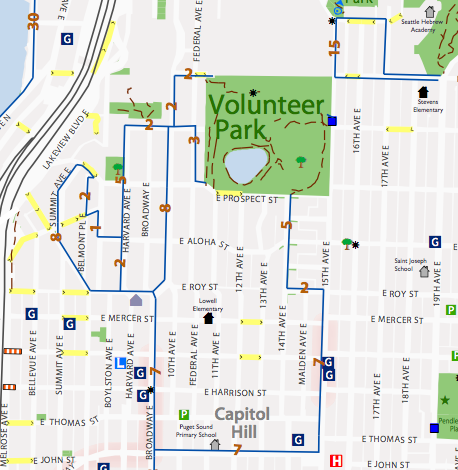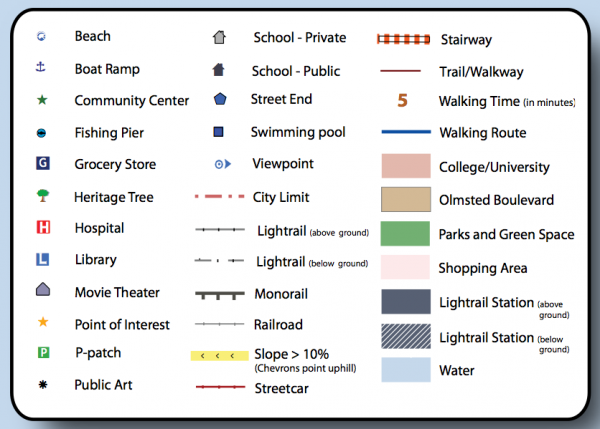
 In the style of the city bicycle map, SDOT has released a city walking map, noting areas where grades become steep and other points of interest to walkers (such as viewpoints and public art). It also notes some walking routes and gives estimates for how long each leg of the walk will take.
In the style of the city bicycle map, SDOT has released a city walking map, noting areas where grades become steep and other points of interest to walkers (such as viewpoints and public art). It also notes some walking routes and gives estimates for how long each leg of the walk will take.
To me, it seems like the most useful aspect of the map is not that it tells you where to walk, but that it tells you where NOT to walk (or ride), unless you want the steep hills. The bike map has chevrons showing grade changes, but it does not specifically note blocks with grades steeper than 10 percent. I almost wish the blocks marked in yellow on this map were given some sort of special notation on the bike map, as well.
The map seems like a really great start. It’s a bit confusing at first, but it doesn’t take long to get used to the notations and symbols (and having a physical copy would help, too). Also, some symbols could probably be dropped (we don’t really need to know where the schools and boat ramps are). It could also be useful to label streets without sidewalks, especially the busier ones.
The most useful thing the city could do for walkers would be to fund even a small amount of the pedestrian master plan, but that’s another post.
Info for the map came from several sources, including Feet First. No word on whether hard copies will be available free through the mail, like the bike map currently is. UPDATE: Just got word that this is in the works. There will be three versions of the map: north, central and south. UPDATE#2: You can now request a hard copy of the map online. From the SDOT Blog:
The routes identified on the map come from a variety of sources including Feet First, King County, and SDOT and include routes that follow sidewalks, shoulders on quiet streets, and park trails. This new series of city walking maps divides Seattle into three sections: north, central, and south. Adjoining sections of the map include a limited amount of overlap, should your route cross from one section to another.
To help you plan your excursion, all of the routes and paths on the map have been labeled with the approximate amount of time in minutes it will take to walk each segment based on the distance to be covered. These estimates do not account for the steepness of the street or the physical condition of the walker, so some routes may take more or less time than suggested.
And now, for something completely different (sorta):








Comments
3 responses to “New SDOT walking map a good step forward – UPDATED x2”
I think having schools marked is nice. They’re often used for public meetings and having them on the map also promotes walking there for kids and parents. Also they often have open space accessible to the public.
Boat ramps I’m not so sure. Carry your kayak to the ramp maybe?
I could see marking playgrounds and playfields, but not every school has them. The map also differentiates between private and public.
But really, the map’s cool. Just nitpicking small details.
My impression is that many of SDOT’s recent pedestrian improvements owe their existence not just to Bridging the Gap but also in large part to SDOT’s Safe Routes to School program. So it makes sense to me that all schools are all marked; the map is probably to a good extent geared at schoolkids and their parents. I also think it’s just nice for consistency: if you’re going to mark any schools—and it would seem silly not to mark huge schools like Franklin or Garfield—it seems like you should mark them all. Agreed, though, that the public/private distinction is odd.
My personal favorite thing about the map is the inclusion of street ends, which are a minor obsession of mine. They’re great walking and biking destinations, and in an hour or two I plan to ride out from Ballard to Laurelhurst to explore some viewpoints and street ends that I didn’t know existed until looking at this map. (SDOT does have a map of all its street ends, but the vast majority are nothing worth visiting. Unless you like to get depressed about how many people steal—er, encroach upon—public waterfront lands with apparent impunity.)